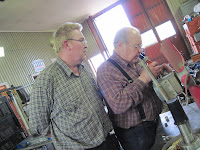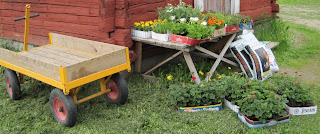"Between the Hägg and the Syren"
Part I
Part I
Our Hägg tree between the källarboden and the lillstuga, just starting to bloom.
Spring is such a beautiful season in the village of Eden,
and it seems to come overnight,
dispelling all the darkness and frigid temperatures of winter
in a surprisingly short time.
to mini-lakes in the driveways and by the sides of the road...
to 'Quick! It's time to clean up the garden!'...
In a little under two weeks!
I am always amazed at how fast it happens.
Hans says that when the frost finally thaws in the ground it is like someone has pulled the plug in the bathtub...
and he is right!
This year I kept a record and our Hägg tree bloomed
during the first week in June.
#1

 These iris, lily and peony plants were brought from the ancestral home of a family friend in the very northernmost area of Sweden and put into the ground at one end of our kitchen garden. Of course the hope was that they would survive the transplanting process and eventually bloom.
These iris, lily and peony plants were brought from the ancestral home of a family friend in the very northernmost area of Sweden and put into the ground at one end of our kitchen garden. Of course the hope was that they would survive the transplanting process and eventually bloom.
and he is right!
This year I kept a record and our Hägg tree bloomed
during the first week in June.
You could smell the sweet scent of it the minute you opened the door, even before the flowers appeared.
The perfume filled the whole house.
There is a tradition in this area of Sweden
that sometimes feels almost like a command.
With the older people it is inviolate, and there is a good reason for that...
because it is TRUE.
They say:
"Everything must be in the ground between the Hägg and the Syren."
That means that all planting and seeding must be accomplished between the first blooms of the Hägg (Bird Cherry) tree and the blooming of the Syren (Lilac bush).
That means that all planting and seeding must be accomplished between the first blooms of the Hägg (Bird Cherry) tree and the blooming of the Syren (Lilac bush).
For us as a family this year, "everything" included much more than just planting and seeding. As you read through this post you will see many other tasks that had to be completed during the same time period.
I will freely admit that there were more than a few moments when it seemed,
in a word,
I will freely admit that there were more than a few moments when it seemed,
in a word,
IMPOSSIBLE.
But it had to be done,
and here is the list:
But it had to be done,
and here is the list:
#1
Clean up, fertilize and till the kitchen garden.
(15m X 30m - roughly 45' X 90')
Remove all the old weeds from last Fall and any winter debris, spread it with dung from the dung heap and get it tilled in and raked smooth.

 These iris, lily and peony plants were brought from the ancestral home of a family friend in the very northernmost area of Sweden and put into the ground at one end of our kitchen garden. Of course the hope was that they would survive the transplanting process and eventually bloom.
These iris, lily and peony plants were brought from the ancestral home of a family friend in the very northernmost area of Sweden and put into the ground at one end of our kitchen garden. Of course the hope was that they would survive the transplanting process and eventually bloom.Both the iris and lilies fulfilled that hope, but for three Springs we had watched in vain for any sign of flowering from the peonies. Before we could dung or till, we had to untangle all the plants from the clutches of last Fall's weeds, by hand, one step at a time.
The strawberry plants that are right next to them were slated to be plowed under but we decided to give them one more year so they also needed to be cleaned up and weeded.
With that done the rest of the garden was ready to be dunged and tilled.
#2
Prepare the hay barn for the new crop.
While I was working in the garden the boys were in the hay barn removing all the old hay that was left from last season and sweeping the entire place clean. Before we knew it haying season would be upon us and we had to have the barn ready to receive the new hay for the coming winter.
These pictures show about half of the hay area in the barn, so it is a big job to clean it and haul out the residue.
#3
Check the ventilation fan in the main barn to make sure it was working properly.
When we did this we discovered that it WASN'T.

 That meant a trip to the village of Åsmon, about forty five minutes away where the small engine repair shop, MEAB, is located.
That meant a trip to the village of Åsmon, about forty five minutes away where the small engine repair shop, MEAB, is located.  Run by a father and son team who are incredibly expert at their craft, they had the fan up on the bench and looked over in a jiffy. They started right in on the repair.
Run by a father and son team who are incredibly expert at their craft, they had the fan up on the bench and looked over in a jiffy. They started right in on the repair.I was reminded again how important it is to check and maintain every piece of equipment on the farm BEFORE there is a problem.
#4
Bring in all the sheep and shear each one.

 Hans is the master in this department. The animals love him and trust him. Shearing them not only keeps them cleaner and more comfortable, it actually affects their metabolism as well. This was our first time to try out the new shearing table that we ordered and it worked like a charm. No more wrestling them to the ground and trying to hold them still while they were being clipped. Slick as a whistle.
Hans is the master in this department. The animals love him and trust him. Shearing them not only keeps them cleaner and more comfortable, it actually affects their metabolism as well. This was our first time to try out the new shearing table that we ordered and it worked like a charm. No more wrestling them to the ground and trying to hold them still while they were being clipped. Slick as a whistle.#5
Put all the seed potatoes into slatted boxes by type and set the boxes by a sunny window for sprouting.
This is NOT the way it is usually done.
Normally, the seed potatoes are taken from the earthen cellar at the first of May and put into the boxes, then set in the carpentry, covered with old carpets to keep them dark.
With that method they are sprouted and ready to plant within three to four weeks.
But this year we were out of time. We needed a 'quick fix', so we put them by a sunny window in the tank room, uncovered, where there was plenty of light and just the right temperature.
While we forged ahead with the other responsibilities on the list,
these were warming up, and in one short week they were sprouting "eyes", and ready to plant.
It wasn't optimal,
but IT WORKED.
#6
(..feeling overwhelmed yet?)
Take the yearly trip to Genbäck's Plantskola to get all the bedding plants, small vegetable sets and herbs.

 Genbäck's is always a great experience. In a small village called Åsele, about an hour away, it is run by a multi-generational family who have been there for close to eighty years. We always get excellent products and service from them, but this year we got even more than usual.
Genbäck's is always a great experience. In a small village called Åsele, about an hour away, it is run by a multi-generational family who have been there for close to eighty years. We always get excellent products and service from them, but this year we got even more than usual.As well as the normal veggies and flowers, one of the younger members of the Genbäck family, a girl in her late teens who was working in the greenhouse, showed us a beautiful young Hägg tree and a pallet full of thriving lilac bushes.
It was perfect timing for us.
Hans had marked a spot for a new Hägg closer to the main house a full year ago but that's as far as we got. We had tried several times to get a man to come with his digger so we could divide some of the lilacs we already had on the farm and transplant them over to make a hedge along one of the fences, but our small job was so far down the priority list that it also just never happened. We came home that day with the new Hägg and seven lilacs. Gustav (great young man that he is), planted them all right up.
and finally for Part I:
#7
Remove all the lights from the Advent tree, take it down and cut it up for firewood.
We had to wait for a dry, sunny day to do this one as it is slippery to try and balance in the scoop of the tractor. But between Hans and Gustav they got'er done!
To this point...
we felt we were keeping up, but just barely.
The pressure was very real.
We missed Manny more than ever at such a busy time, but also felt happy for his success and sterling accomplishments on his mission in Latvia.
We knew he was where he should be, doing what he should be doing.
And that was and is a great comfort.
Pappa always says,
"Do what is right, let the consequence follow".
So we did.
(Stay tuned for Part II)






















1 comment:
Manny (Emanuel) is a very nice missionary, who now has two weeks is my Elder. He really is there where he should be and doing what he should do. Thanks to him! Thank you for him;)
Post a Comment